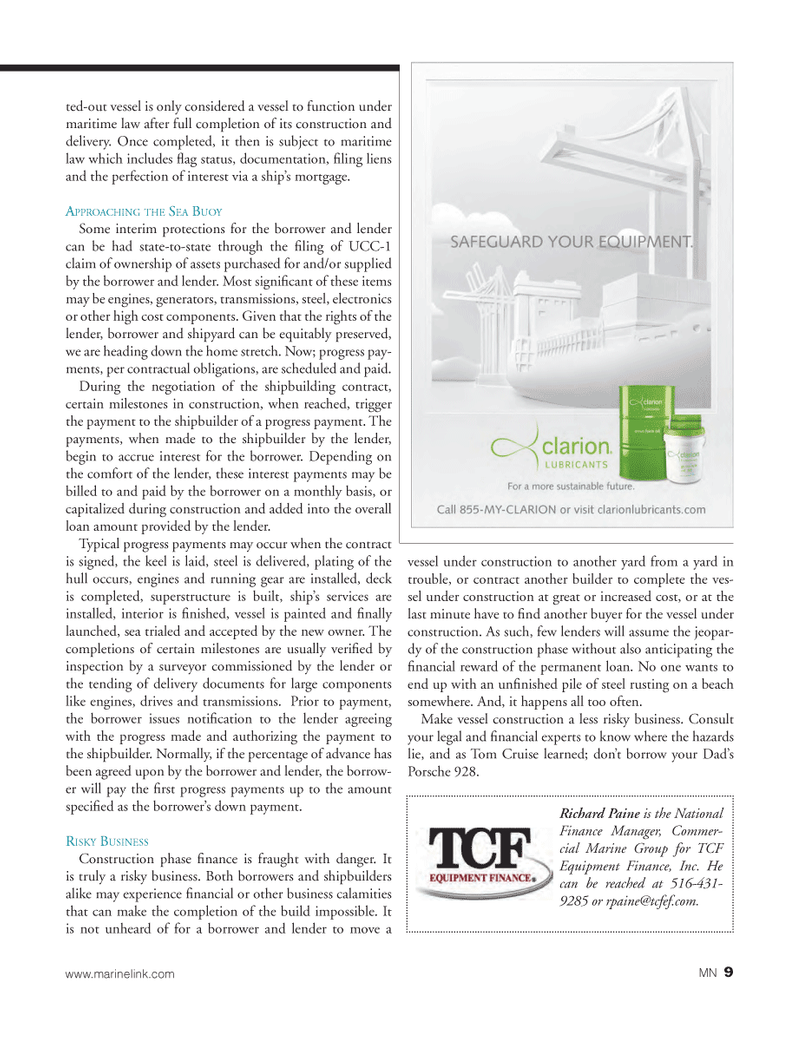
Page 9: of Marine News Magazine (June 2013)
Dredging & Marine Construction
Read this page in Pdf, Flash or Html5 edition of June 2013 Marine News Magazine
ted-out vessel is only considered a vessel to function under maritime law after full completion of its construction and delivery. Once completed, it then is subject to maritime law which includes ß ag status, documentation, Þ ling liens and the perfection of interest via a shipÕs mortgage. APPROACHING THE SEA BUOY Some interim protections for the borrower and lender can be had state-to-state through the Þ ling of UCC-1 claim of ownership of assets purchased for and/or supplied by the borrower and lender. Most signiÞ cant of these items may be engines, generators, transmissions, steel, electronics or other high cost components. Given that the rights of the lender, borrower and shipyard can be equitably preserved, we are heading down the home stretch. Now; progress pay- ments, per contractual obligations, are scheduled and paid. During the negotiation of the shipbuilding contract, certain milestones in construction, when reached, trigger the payment to the shipbuilder of a progress payment. The payments, when made to the shipbuilder by the lender, begin to accrue interest for the borrower. Depending on the comfort of the lender, these interest payments may be billed to and paid by the borrower on a monthly basis, or capitalized during construction and added into the overall loan amount provided by the lender. Typical progress payments may occur when the contract is signed, the keel is laid, steel is delivered, plating of the hull occurs, engines and running gear are installed, deck is completed, superstructure is built, shipÕs services are installed, interior is Þ nished, vessel is painted and Þ nally launched, sea trialed and accepted by the new owner. The completions of certain milestones are usually veriÞ ed by inspection by a surveyor commissioned by the lender or the tending of delivery documents for large components like engines, drives and transmissions. Prior to payment, the borrower issues notiÞ cation to the lender agreeing with the progress made and authorizing the payment to the shipbuilder. Normally, if the percentage of advance has been agreed upon by the borrower and lender, the borrow- er will pay the Þ rst progress payments up to the amount speciÞ ed as the borrowerÕs down payment. RISKY BUSINESSConstruction phase Þ nance is fraught with danger. It is truly a risky business. Both borrowers and shipbuilders alike may experience Þ nancial or other business calamities that can make the completion of the build impossible. It is not unheard of for a borrower and lender to move a vessel under construction to another yard from a yard in trouble, or contract another builder to complete the ves- sel under construction at great or increased cost, or at the last minute have to Þ nd another buyer for the vessel under construction. As such, few lenders will assume the jeopar- dy of the construction phase without also anticipating the Þ nancial reward of the permanent loan. No one wants to end up with an unÞ nished pile of steel rusting on a beach somewhere. And, it happens all too often. Make vessel construction a less risky business. Consult your legal and Þ nancial experts to know where the hazards lie, and as Tom Cruise learned; donÕt borrow your DadÕs Porsche 928. Richard Paine is the National Finance Manager, Commer- cial Marine Group for TCF Equipment Finance, Inc. He can be reached at 516-431- 9285 or [email protected]. MN 9www.marinelink.com MN June2013 Layout 1-17.indd 9MN June2013 Layout 1-17.indd 95/30/2013 11:04:44 AM5/30/2013 11:04:44 AM

 8
8

 10
10
